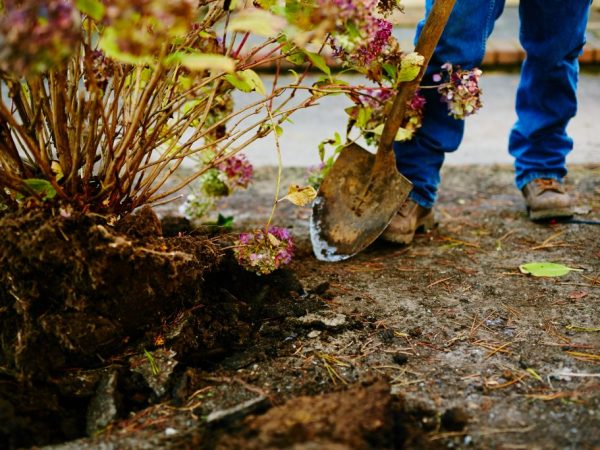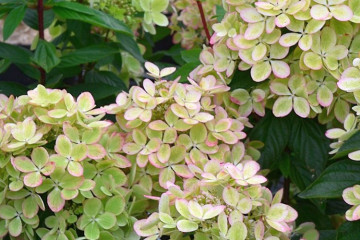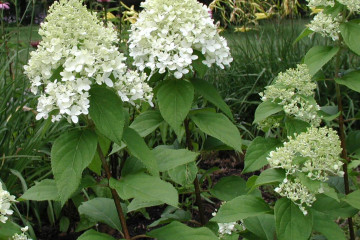Hydrangea Magical Sweet Summer (Hydrangea Paniculata Magical Sweet Summer)
Content:
Hydrangea Magical Sweet Summer, like other varieties of this plant species, belongs to the genus Hydrangea. The largest number of wild species of this genus is found on the islands of Japan and China. This is an amazing variety, the cultivation of which has its own nuances, they must be taken into account when planning to plant a flower on your site.
Origin and appearance
Hydrangea Magic Sweet Summer is a shrub 1.2-1.5 m high. The flowering period is from July to September. Panicle inflorescence, almost entirely composed of sterile flowers.
How the Magical Sweet Summer hydrangea blooms
The opening buds are slightly greenish in color, and as they grow and develop, the flowers become creamy white. In autumn, at the end of flowering, light pink, pink-greenish and white flowers can be seen on the inflorescences at the same time. The severity of a particular shade depends on external conditions: light intensity, soil composition, weather conditions, etc.
In landscape design it is used as a specimen (single planting), in group plantings and in compositions with other plants.
Transplant after purchase in open ground
It is better to replant hydrangea in early spring or autumn. Doing this in the summer during flowering is not recommended. The hydrangea will shed flowers and buds and refuse to bloom for the next season.
What is needed for landing
For planting, you need to prepare the plant itself and a new hole.
Step-by-step instruction:
- Water the hydrangea pot well on the eve of planting.
- Place in a dark place.
- Spray the crown well.
Pit preparation:
- Prepare a planting pit measuring 50 × 50 × 50 cm.
- Spill the hole with water a day before the transplant.
- Place 20 cm of hydrangea soil on the bottom.
- Add 20 g of superphosphate and potassium sulfate.
Choosing the best place
This variety should be planted in a sunny place or in partial shade. The soil is preferable fertile, well moistened and drained with an acidic reaction (pH 4.5-5).
Hydrangea growing in the wrong place will not bloom and develop well.
An ideal planting site should meet the following requirements:
- diffused lighting. Direct sunlight appears only in the morning;
- quiet, sheltered from the winds;
- moist soil, but no stagnant water;
- acidic soil reaction (pH 4.5-5).
Step-by-step planting process
To properly plant a hydrangea, you need to take the following steps:
- Tie the branches of the bush with rope.
- Remove the plant with roots and a lump of soil from the shipping pot.
- Set the bush in the hole, sprinkle with soil mixture on the sides.
- Leave the root collar at ground level.
- Water the plant abundantly.
- Mulch with sawdust or hardwood bark.
Reproduction
When buying a seedling or seeds of a certain hydrangea variety, growers run the risk of getting the wrong variety that they planned. Self-propagation guarantees the transfer of varietal traits and is a fun process in and of itself. The most common options for how to do this.
Propagation by cuttings
Propagating by green cuttings is the easiest and most affordable option.
Planting material is prepared in mid-July. Cuttings will take root well:
- from young plants or from those that have undergone anti-aging pruning;
- cut from the side branches in the lower, well-lit part of the bush;
- free from signs of diseases and pests;
- collected in the early morning.
Rooting order:
- After cutting, the shoots are immediately placed in water.
- Remove the top with a bud from the shoot.
- Divide the rest into sections with 2-3 pairs of leaves.
- Remove the lower leaves from each cutting, cut the upper leaves by a third.
- Place the cuttings in a rooting stimulant solution for 2 hours.
- Rooting is carried out in a moistened mixture of sand and peat (1: 2).
- Cover the cuttings with a jar.
- Water 2-3 times a week.
- The banks can be removed after 25-30 days.
The grown bushes are planted in a permanent place in the fall. For the winter, young plants are insulated with a covering material on the frame, and on top - with spruce branches.
Growing from cuttings
Propagated by layering in early spring.
Description of the order of reproduction by layering:
- Loosen and level the soil around the bush.
- Place and pin several lower shoots into the radial grooves.
- By the end of summer, 2-3 young plants are formed on each layer.
- When the babies reach a size of 15-20 cm, they begin to spud to form lateral roots.
- In October, the babies can be separated from the mother plant and buried in until spring.
Dividing the bush
By dividing, the hydrangea is propagated during transplantation. Paniculate varieties, including Magic Sweet Summer, do not tolerate this procedure very well.
Hydrangea Care Magic Sweet Summer
Hydrangea loves moisture, it cannot be overdried. You need to water with slightly acidified water.
In the heat, watering is carried out twice a week.
Top dressing
For abundant and long flowering, hydrangea must be fed at least 2 times a year. The first time fertilization is applied in the spring before the buds appear, the second - in the fall after flowering. In the spring, fertilize with a solution of urea (1 teaspoon per 1 liter of water). Each bush will need 30 liters of solution. In the fall, a complex fertilizer is applied.
Features of care during the flowering period
During flowering, the plant needs regular, abundant watering. At the very beginning of the opening of the buds, you can feed the bushes with a solution of mullein or chicken droppings (1:10).
Features of care during the rest period
After the plant has bloomed, it is prepared for wintering:
- remove wilted inflorescences;
- spud the base of the bush;
- mulch the earth;
- covered with spunbond on arcs. For panicle hydrangeas, this is extremely necessary only if the planting region has severe winters.
Preparing for winter
Even if the winter is predicted to be mild, it is better to play it safe and cover the bushes. This is usually done in October. The branches are tied, pressed to the ground and covered with spunbond or lutrasil. Then a metal mesh is installed around the bush, fallen leaves are poured into the resulting cylinder.
The panicle hydrangea Magic Sweet Summer combines many of the positive qualities of the members of its family. Therefore, this variety is so popular and is actively used in landscape design. Sweet Summer is the most suitable variety for the climatic conditions of Central and northern Russia.


















